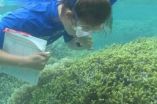(Press-News.org) U.S. MILITARY ACADEMY, WEST POINT, N.Y.—How could a colorblind animal know how to change its skin color to blend into its surroundings? And what will the animal's predator "see," looking at its prey before and after it hides?
These provocative questions are addressed in article published today by a collaborative team from the Marine Biological Laboratory (MBL) in Woods Hole, Mass., and the U.S. Military Academy in West Point, N.Y. The article, "Hyperspectral imaging of cuttlefish camouflage indicates good color match in the eyes of fish predators," appears in Proceedings of the National Academy of Sciences (PNAS).
"What makes camouflage effective? The answer is that it's an opinion, and that opinion completely depends on who is being asked. Our work presented in this paper takes the field a step closer to quantifying camouflage effectiveness," says J. Kenneth Wickiser, Asst. Prof. in the Department of Chemistry and Life Science at the U.S. Military Academy in West Point.
Understanding the principles of camouflage is not only important in biology, but also provides insights into architecture, advertisement, and defense applications.
For this study, the team studied camouflage in the marine animals known as coleoid cephalopods (octopus, squid, and cuttlefish). Camouflage is the primary defense in these animals and their rapidly adaptable body patterning system is among the most sophisticated in the animal kingdom. The expression of camouflage body patterns in cuttlefish is a visually driven behavior. Previous studies have shown that certain background variables—such as brightness, contrast, edge
and size of objects, etc.—are essential for eliciting camouflaged body patterns. However, cephalopod eyes lack color perception, thus the vexing question of how they achieve effective camouflage while being colorblind still remains.
Moreover, camouflage studies suffer from the inability to assess the effectiveness of camouflage in the visual space of predators; in short, it is difficult to determine whether a predator actually visually picks out the prey from the background environment. Knowledge of the visual capabilities of many predators is surprisingly lacking. Thus, the team asked, how does a colorblind animal change its color to blend into its surroundings, how do predators actually "see" their prey?
"To tackle this incredibly difficult problem, we put together a team with Chuan-Chin Chiao as a vision expert, Roger Hanlon and his scientists at the MBL as world leaders in cuttlefish and camouflage biology, and combined it with our expertise in hyperspectral imagery analysis at West Point," says Wickiser.
The team exploited a new imaging technology (HyperSpectral Imaging, HSI) to more accurately measure color match between animal and background, and to enable them to model camouflage in the eyes of predators. HSI employs a camera that captures not just 3 narrow windows (Red, Green, Blue – RGB) like human eyes or typical digital cameras do rather it captures the entire spectrum using 540 windows. In essence, HSI offers the opportunity to "see" things that humans, and many predators, cannot because of the limitations on our eyes. Because of the wealth of information HSI images provide, the scientists could extract a small amount of that data and compile an image from the perspective of a predator.
Importantly, modeling color vision of potential di- and tri-chromatic (RG or RGB capable) fish predators of cuttlefish corroborated the spectral match analysis and revealed that much of the contrast information (which allows a predator to "pick out" a cuttlefish from the background environment) resides in the brightness (luminance) rather than in the color (chromatic) aspect of the reflected light. What this means is that cuttlefish camouflage strategies take away a tool from predators in their ability to pick out their prey from the background and instead leave them with only brightness as a method for prey identification.
These findings (i) indicate the strong potential of HSI technology to evaluate camouflage body patterns simultaneously in the spatial and spectral domains, (ii) provide supporting evidence that cuttlefish can produce color-coordinated camouflage on natural substrates despite lacking color vision, and that (iii) the color aspect of cuttlefish camouflage is highly effective against fish predators. This is the first time that color matching in camouflaged animals has been visualized more realistically through the eyes of their potential predators.
"So much is unknown about how predators actually see their prey. Using hyperspectral imagery tools is a huge advance in getting us the information we need to model predator vision," says Wickiser. "We hope our work takes us one step closer to understanding how a colorblind animal adopts near-perfect camouflage in a variety of backgrounds."
The color-changing abilities of cephalopods have been appreciated since Aristotle's time. Although this topic has received much attention in the past, no quantitative assessment has been made to examine the color match between animal and background. Applying hyperspectral imaging system and modeling the predator's visual system adds a new dimension to quantifying animal camouflage in the eyes of the beholders. The team's findings provide strong support that cuttlefish are capable of hiding in plain sight of their visual predators. Furthermore, this approach may prove to be tranformational in the way that color is quantified in sensory studies of camouflage and signaling in the natural world.
INFORMATION:
Citation:
Chiao, C-C, Wickiser, J.K., Allen, J.J., Genter, B., and Hanlon, R.T. Hyperspectral imaging of cuttlefish camouflage indicates good color match in the eyes of fish predators. PNAS Early Edition, week of May 16, 2011.
About West Point
The U.S. Military Academy is a four-year co-educational federal undergraduate liberal arts college located 50 miles north of New York City. Founded in 1802 as America's first college of engineering, it consistently ranks as one of the top colleges in the nation. A pre-eminent leader development institution, its mission remains constant - to educate, train and inspire cadets for careers of professional service to the Army and the nation. For more information go to www.westpoint.edu.
The Marine Biological Laboratory (MBL) is dedicated to scientific discovery and improving the human condition through research and education in biology, biomedicine, and environmental science. Founded in 1888 in Woods Hole, Massachusetts, the MBL is an independent, nonprofit corporation.
How can a colorblind animal change its colors to blend into the background?
Team from MBL, West Point uses new imaging technology to 'see' camouflaged marine animals in the eyes of their predators
2011-05-17
ELSE PRESS RELEASES FROM THIS DATE:
New solar product captures up to 95 percent of light energy
2011-05-17
Efficiency is a problem with today's solar panels; they only collect about 20 percent of available light. Now, a University of Missouri engineer has developed a flexible solar sheet that captures more than 90 percent of available light, and he plans to make prototypes available to consumers within the next five years.
Patrick Pinhero, an associate professor in the MU Chemical Engineering Department, says energy generated using traditional photovoltaic (PV) methods of solar collection is inefficient and neglects much of the available solar electromagnetic (sunlight) spectrum. ...
Molecular technique advances soybean rust resistance research
2011-05-17
A new tool is available to select for soybean rust resistance in breeding populations, said Glen Hartman, University of Illinois professor of crop sciences and USDA-ARS scientist. Hartman and his team of researchers successfully used quantitative polymerase chain reaction (Q-PCR) assays to assess fungal DNA in soybean leaf tissue to quantify the level of resistance in individual plants with resistance to soybean rust.
"This is not a new technique," Hartman said. "But it is a new tool for use in soybean rust resistance breeding, which has typically used phenotyping or ...
Contrast agent guidelines help prevent debilitating disorder
2011-05-17
OAK BROOK, Ill. – A simple blood test may help prevent a serious complication associated with a contrast agent commonly used in MRI exams, according to a study published in the July issue of Radiology.
Within the past five years, use of gadolinium-based contrast agents (GBCA) has been linked to the development of nephrogenic systemic fibrosis (NSF), a rare disorder mainly affecting patients with severe kidney disease. But since 2008, restrictive GBCA administration guidelines implemented by Massachusetts General Hospital have proven effective in preventing NSF.
"It ...
Deer tick bacteria DNA in joint fluid not reliable marker of active lyme arthritis
2011-05-17
New research shows that polymerase chain reaction (PCR) testing for Borrelia burgdorferi DNA—the spirochetal bacteria transmitted by deer ticks—in joint fluid may confirm the diagnosis of Lyme arthritis, but is not a reliable indicator for active joint infection in patients whose arthritis persists after antibiotic therapy. Findings of this study are published in Arthritis & Rheumatism, a journal of the American College of Rheumatology (ACR).
Lyme disease is caused by the B. burgdorferi bacteria, which is transmitted to humans by the bite of an infected blacklegged tick, ...
Sewage-derived nitrogen increasingly polluting Caribbean ecosystems
2011-05-17
Nitrogen pollution in our coastal ecosystems, the result of widespread use of synthetic agricultural fertilizers and of human sewage, leads to decreased water transparency, the loss of desirable fish species, and the emergence of toxic phytoplankton species—such as the algae behind the renowned "red tides" that kill fish.
The effects are particularly pronounced in the Gulf of Mexico and the Caribbean.
A study published in the journal Global Change Biology finds that while fertilizer has been the dominant source of nitrogen pollution in Caribbean coastal ecosystems for ...
Santander Launches New Mortgage Products
2011-05-17
From Friday 13 May, Santander, the 'Home of UK Mortgages' is launching a new three year fixed Homebuyer product at 85 per cent LTV, at 5.49 per cent with NO fee ''ideal for those homeowners looking to buy. The new product also comes with Santander's Homebuyer Solution which offers the added benefits of a free basic mortgage valuation and GBP250 cash-back on completion.
In addition, Santander is also reducing rates on a selection of its two year fixed products:
- Rate reduced by 0.10 per cent on two-year fix at 80 per cent LTV for homebuyers, now 4.19 per cent with ...
E-Book Systems Chosen to Create Prevention Forum Online Magazine
2011-05-17
E-Book Systems, creator of the patented Digital Flip(R) e-publishing technology, announces Prevention First has adopted its 3-D page-flipping FlipViewer(R) Xpress viewer format for its Forum online magazines.
Founded in 1980, Prevention First is a nonprofit 501(c)(3) dedicated to preventing teen alcohol and other drug use, and the many related issues that result from that abuse. They reach millions of teens, parents, educators and others in Illinois.
"We were looking for a cost-effective way to produce our publications and eliminate high print and mail costs ...
Cannes 2011 Sees the Launch of All-in-One Finnish Website, Filmland.fi
2011-05-17
During the 2011 edition of the Cannes Film Festival and Marche du Film at a karaoke bar "alternative dinner party", Petra Theman, CEO of FAVEX, i.e. Finnish Film & Audiovisual Export, is launching Filmland.fi (http://www.filmland.fi):
"The Finnish audiovisual industry is blooming and new creative talent has given us everything from angry birds to space Nazis, rare Santa Clauses for export and lots of stories and characters in between. Also filming in Finland is easy and hassle free. Now Filmland.fi is bringing you all the info you need to be up-to-date, ...
ArtistScope Launches The Most Secure Site Protection Imaginable
2011-05-16
ArtistScope launches the most secure web site protection system for copy protecting web pages, data and all embedded media without data leakage and other exploits enabled by modern web browsers.
The ArtistScope Site Protection System, ASPS, provides the most secure copy protection for web pages and is the only solution recommended where the prevention of copy and unauthorized redistribution is mission critical. Protect images, html, source code, Flash, movies, PDF, database records and other web content without data leakage and other exploits enabled by modern web browsers. ...
Brimstone and the Borderhounds to be Featured in Barnes & Noble
2011-05-16
Hound Comics, Inc. CEO William 'Brimstone' Kucmierowski announced that Barnes & Noble Bookstores increased the distribution of the flagship brand Brimstone and the Borderhounds. Headlining their regular distribution, Brimstone and the Borderhounds will be featured in over seven hundred Barnes & Noble retail locations across the nation.
As of this coming July, the enlargement of the distribution will be coupled with special promotional placement at all Barnes & Noble stores. Brimstone announced that with this massive increase of distribution comes a major ...
LAST 30 PRESS RELEASES:
Numbers in our sights affect how we perceive space
SIMJ announces global collaborative book project in commemoration of its 75th anniversary
Air pollution exposure and birth weight
Obstructive sleep apnea risk and mental health conditions among older adults
How talking slows eye movements behind the wheel
The Ceramic Society of Japan’s Oxoate Ceramics Research Association launches new international book project
Heart-brain connection: international study reveals the role of the vagus nerve in keeping the heart young
Researchers identify Rb1 as a predictive biomarker for a new therapeutic strategy in some breast cancers
Survey reveals ethical gaps slowing AI adoption in pediatric surgery
Stimulant ADHD medications work differently than thought
AI overestimates how smart people are, according to HSE economists
HSE researchers create genome-wide map of quadruplexes
Scientists boost cell "powerhouses" to burn more calories
Automatic label checking: The missing step in making reliable medical AI
Low daily alcohol intake linked to 50% heightened mouth cancer risk in India
American Meteorological Society announces Rick Spinrad as 2026 President-Elect
Biomass-based carbon capture spotlighted in newly released global climate webinar recording
Illuminating invisible nano pollutants: advanced bioimaging tracks the full journey of emerging nanoscale contaminants in living systems
How does age affect recovery from spinal cord injury?
Novel AI tool offers prognosis for patients with head and neck cancer
Fathers’ microplastic exposure tied to their children’s metabolic problems
Research validates laboratory model for studying high-grade serous ovarian cancer
SIR 2026 delivers transformative breakthroughs in minimally invasive medicine to improve patient care
Stem Cell Reports most downloaded papers of 2025 highlight the breadth and impact of stem cell research
Oxford-led study estimates NHS spends around 3% of its primary and secondary care budget on the health impacts of heat and cold in England
A researcher’s long quest leads to a smart composite breakthrough
Urban wild bees act as “microbial sensors” of city health.
New study finds where you live affects recovery after a hip fracture
Forecasting the impact of fully automated vehicle adoption on US road traffic injuries
Alcohol-related hospitalizations from 2016 to 2022
[Press-News.org] How can a colorblind animal change its colors to blend into the background?Team from MBL, West Point uses new imaging technology to 'see' camouflaged marine animals in the eyes of their predators





